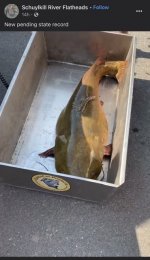By the way, Susquehanna, I enjoyed your reference to “pesky” biologist reports. Never heard it phrased that way. Glad you included some in addition to the hot off the press one that I referenced regarding the Delaware R SMB population from years of study.
I would also specifically call people’s attention to the Michigan State study of the Susquehanna YOY disease problem brought on by warm water temps, which appeared in your list of references. They were able to produce the same response in the lab as was seen in YOY in the Susquehanna.
Fly swatter’s comment that refers generally to the route that introductions take at the population level is dead on in my real-world experience. The populations of introduced aquatic organisms grow exponentially once they get a good start, then growth and abundance tails off (usually) and eventually reaches some equilibrium well below peak level. Unfortunately, for some organisms that equilibrium is still at a high population density in some systems while in others it is at a low population density after having hit an extremely high density at one point, eating themselves out of house and home. Good example of the former: Lake Galena white perch, Bucks Co. Good example of the latter: Lake Nockamixon white perch, Bucks Co. Two lakes about 10 mi apart.
Given the length of the Susquehanna and its major tribs, the flathead populations are in various stages of growth depending upon the location. It would not surprise me if it would be later found that they peaked in recent years or will very soon in the lower Susquehanna, given the sizes of adults that are now being produced and their cannibalistic habits. Note also that young flatheads up to 18 inches feed very heavily on crayfish and it just so happened that when flatheads were introduced to the Susquehanna rusty crayfish, another exotic, were extremely abundant, providing an ideal forage base for the first year classes of flatheads to kick start the population in a big way.
But no, no we are to believe that while flatheads were and are surrounded by a perfect forage base of abundant crayfish (at least then), gizzard shad, shiners, suckers, quillback, channel cats, and carp, they prefer to search out the much less abundant predator, the SMB, even in the face of a very abundant, fusiform, easily caught and consumed predator in the lower Susquehanna, the walleye. This reminds me of how LMB anglers in certain circles blame poor LMB fishing on Muskellunge, despite a Wisconsin stomach analysis of over 1000 muskies that showed bass being about 3% of the contents (yellow perch were the primary diet). Most predators are opportunistic (flatheads classified as opportunistic) and focus on prey that are most abundant and require the least energy to capture.




